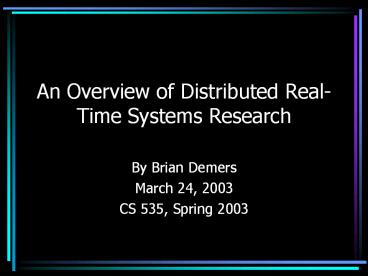An Overview of Distributed RealTime Systems Research - PowerPoint PPT Presentation
Title:
An Overview of Distributed RealTime Systems Research
Description:
Examine efforts to combine real-time and distributed computing ideas ... Cheap. Widely used. Cons. Not designed for real-time use. Packet arrival times can vary widely ... – PowerPoint PPT presentation
Number of Views:38
Avg rating:3.0/5.0
Title: An Overview of Distributed RealTime Systems Research
1
An Overview of Distributed Real-Time Systems
Research
- By Brian Demers
- March 24, 2003
- CS 535, Spring 2003
2
Project Overview
- Examine efforts to combine real-time and
distributed computing ideas - Summarize trends, focal points
- Tried not to filter ideas
- Examine one or more sample implementations (if
possible) - Work in progress!
3
Presentation Overview
- Definitions of key terms, issues
- Discussion of key research areas, developments
- Networks
- Scheduling
- To-do list
- Conclusions, questions, suggestions
4
Definitions
- Hard vs. soft real-time
- Distributed systems
- Did not consider traditional parallel computers
- General focus soft RT systems
5
Networking
6
Networking
- Inherently non-deterministic
- Research focus is on LAN configurations
- Main approaches
- Improve determinism of existing protocols
- Use probabilistic approach
7
Ethernet
- Pros
- Cheap
- Widely used
- Cons
- Not designed for real-time use
- Packet arrival times can vary widely
8
Ethernet Improvements
- Halmsted University
- Hardware solution Propose a network connected
exclusively by switches (eliminating collisions) - Switches perform data buffering, manage real-time
streams
Switch
9
Ethernet Improvements (cont.)
- Traffic smoothing (Kweon, Shin, and Workman)
- Probabilistically limit traffic into network
- Virtual token ring (Chiueh and Venkatramani)
- Switch to token-based scheme when RT traffic
detected
Higher Network Layers
Regulator
Data-link Layer
Traffic smoothing approach
10
Token-Based Protocols
- Pros
- Fairly deterministic (for a network)
- Cons
- Not as widely available
- Latencies can be high (according to some)
11
Token-Based Protocols (cont.)
- FDDI (Fiber Distributed Data Interface)
- Uses token-based, ring topology
- Data rates equivalent to Fast Ethernet
- Fault tolerant
- RTFC (RT Fiber Communications)
- Not much recent work on IEEE 802.5
12
Scheduling
13
Scheduling
- Packet scheduling
- Task scheduling
- Resource scheduling
14
Packet Scheduling
- Vital for RT communications
- Some probabilistic work
- Some work with co-scheduling RT and non-RT packets
15
Packet Scheduling (cont.)
- Concatenated Hybrid Automatic Repeat Request
(Uhlemann et al.) - Repeated transmissions
- Signal averaging
- (m, k) scheduling (Hamdaoui and Ramanathan)
- Some work on a distance-based priority scheme to
guarantee this - Extended to multi-hop networks
16
Packet Scheduling (cont.)
- Combining RT traffic with non-RT traffic
(Chakraborty, Gries, and Thiele) - Use Earliest Deadline First (EDF) scheduling
- Assign deadlines so that RT NRT traffic can
coexist - Claimed 25-45 improvement for NRT traffic
17
Task Scheduling
- Landmark paper Liu Layland (1973)
- Analyzed static and dynamic scheduling (single
processor) - Many efforts to extend this
- Distributed Generalized Multiframe (DGMF) model
(Chen, Mok, and Baruah) - Presents new analytical framework
18
Task Scheduling (cont.)
- Breaking tasks into subtasks (Kao and
Garcia-Molina) - Setting subtask deadlines
- Methodologies, performance issues
Task
Subtask
Sub-task
Subtask
Subtask
19
Task Scheduling (cont.)
- Resource fragmentation (Bestavros)
- Load balancing
- Potentially bad for CPU-intensive jobs
Example
70
60
50
CPU 1
CPU 2
CPU 3
20
Sample Systems
21
Sample DRT Systems
- Everyone cites the same examples
- Air-traffic control, factory automation, nuclear
power plants, etc. - Difficult to find much info about these topics!
- Some work from avionics
- Possibly some air-traffic systems (FAST?)
22
Summary
23
Distributed RT Research Focus
- Networking
- Extending Ethernet to RT apps
- Packet scheduling issues
- Working with soft RT systems
- Leads to probabilistic techniques
24
To-do Remaining Efforts
- More detail on resource usage, scheduling
- RT evaluation of token-based networks
- Find and examine sample implementation
25
Questions/Suggestions?































